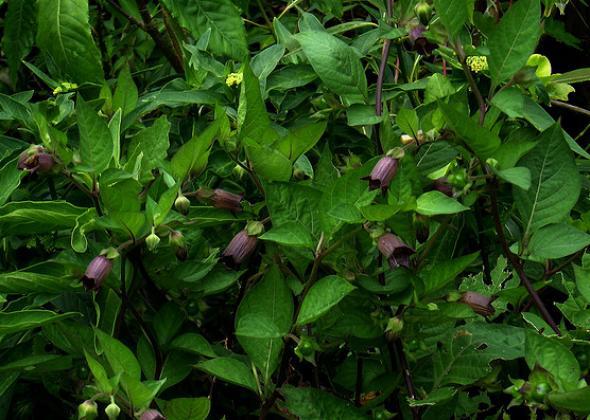All week on Wild Things, we’ll be presenting our favorite dangerous, horrifying, and monstrous plants, excerpted from The Big, Bad Book of Botany: The World’s Most Fascinating Flora by Michael Largo. Out now from William Morrow.
Atropa belladonna is a Eurasian perennial with reddish, bell-shaped flowers that bear glossy-coated, black berries. Other names for the plant include belladonna, deadly nightshade, devil’s berries, naughty man’s cherries, death cherries, beautiful death, and devil’s herb. The plant earns its sinister nicknames, as its foliage and berries are extremely toxic, containing potent dosages of tropane alkaloids. Its most common name, belladonna, derives from Italian, meaning “beautiful woman.” Historically, women have used the herb’s oil to dilate and enlarge the pupils for seductive effect. But it’s best known as the plant of choice for assassins through history.
A native to Europe, North Africa, and Western Asia, the herb grows wildly in many parts of the United States, mostly in dumps, quarries, near old ruins, under shade trees, or atop wooded hills. Belladonna is a branching plant that often grows to resemble a shrub of about 4 feet in height within a single growing season. Its leaves are long, extending 7 inches, and its bell-shaped flowers are purple with green tinges, about an inch long. The fruit and berries appear green when growing, but, as the toxins get stronger in the ripening stage, turn a shiny black color. Belladonna blooms in midsummer through early fall, and its roots are thick, fleshy, and white, growing to about 6 inches or more in length.
Deadly nightshade is one of the most toxic plants in the Eastern Hemisphere. While the roots are the most deadly part, the poisonous alkaloids run through the entirety of the plant. Scopolamine and hyoscyamine are among these toxins, both of which cause delirium and hallucinations. Deadly nightshade berries pose the greatest danger to children, as they are attractive and are deceptively sweet at first bite. Yet just two berries can kill a child who eats them, and it takes only 10 or 20 to kill an adult. Likewise, consuming even a single leaf can prove fatal to humans. Cattle, horses, rabbits, goats, and sheep can eat deadly nightshade without ill effect, though many pets are vulnerable to its lethal effects. Symptoms of deadly nightshade poisoning present quickly, so if medical aid is far off, drink a large glass of warm vinegar or a mixture of mustard and water, which may dilute and neutralize its toxicity.
Though today we understand the risks involved in using deadly nightshade outweigh any potential benefits, it has a long history in medicine and cosmetics, and as a weapon. Ancient Romans harnessed the effects of the plant to make poison-tipped arrows guaranteed to kill, and still others found it an effective anesthesia for surgery, as numbness and drowsiness are side effects of its toxic mix.
If you wish to grow your own crop of the herb, soak the seeds in refrigerated water for two weeks, replacing the water daily. Plant the seeds immediately after two weeks—the young seeds will need sufficient moisture if they’re to germinate successfully, so choose a plot outdoors in May, when there is no fear of frost, and after a strong rain, when the soil is fairly moist. Place the seeds 18 inches apart from one another, and make sure to keep the soil free of weeds or other plants. First-year plants should be thinned out to about 2 1/2 to 3 feet to avoid overcrowding in the next year.
Because it’s so difficult to grow, belladonna rarely appears in gardens. Though it’s cultivated for medicinal purposes in England, France, and North America, the herb has no major value as food. Some home gardeners plant it for its large, colorful display of berries, but remember: This beauty blooms with no printed warning signs, and it’s a risky and deadly choice to grow it haphazardly.
Belladonna is rightfully known as the plant used most throughout the history of stealth assassination. Spies, as well as taste-testers hired by kings and the wealthy to sample food for poisons, learned that it’s possible to develop a tolerance to belladonna. By exposing himself to the toxins by taking small sips of a brew made from the plant over time, an assassin could demonstrate a drink was safe to consume, and his mark would swallow the poison willingly. Made from the plant’s berries, such a drink retains a sweet taste, and can pass as a fermented beverage. According to history, Scotland’s King Duncan I, in 1030, passed around bottles of the deadly drink to an army of Danes, which killed them all without his having to lift a sword. For so-called witches, belladonna is the supposed main ingredient allowing broomsticks to levitate. And perhaps it did, even if only in their hallucinations.
Excerpted from The Big, Bad Book of Botany: The World’s Most Fascinating Flora by Michael Largo. Out now from William Morrow, an imprint of HarperCollins Publishers. Reprinted by permission.
Update, Aug. 20, 2014: A drawing originally at the top of this post did not depict the flowers correctly; it has been replaced with a photo of Atropa belladonna. In addition, the post has been updated to clarify that the nightshade being discussed throughout is deadly nightshade.
